
Mary I, also known as Mary Tudor, and as "Bloody Mary" by her Protestant opponents, was Queen of England and Ireland from July 1553 and Queen of Spain and the Habsburg dominions as the wife of King Philip II from January 1556 until her death in 1558. She is best known for her vigorous attempt to reverse the English Reformation, which had begun during the reign of her father, King Henry VIII. Her attempt to restore to the Church the property confiscated in the previous two reigns was largely thwarted by Parliament, but during her five-year reign, Mary had over 280 religious dissenters burned at the stake in the Marian persecutions.

The House of Tudor was an English and Welsh dynasty that held the throne of England from 1485 to 1603. They descended from the Tudors of Penmynydd, a Welsh noble family, and Catherine of Valois. The Tudor monarchs ruled the Kingdom of England and the Lordship of Ireland for 118 years with five monarchs: Henry VII, Henry VIII, Edward VI, Mary I and Elizabeth I. The Tudors succeeded the House of Plantagenet as rulers of the Kingdom of England, and were succeeded by the Scottish House of Stuart. The first Tudor monarch, Henry VII, descended through his mother from the House of Beaufort, a legitimised branch of the English royal House of Lancaster, a cadet house of the Plantagenets. The Tudor family rose to power and started the Tudor period in the wake of the Wars of the Roses (1455–1487), which left the main House of Lancaster extinct in the male line.

Katherine Seymour, Countess of Hertford was a younger sister of Lady Jane Grey.
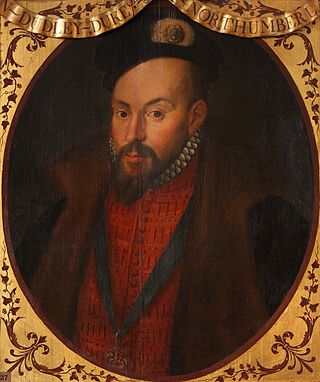
John Dudley, 1st Duke of Northumberland was an English general, admiral, and politician, who led the government of the young King Edward VI from 1550 until 1553, and unsuccessfully tried to install Lady Jane Grey on the English throne after the King's death. The son of Edmund Dudley, a minister of Henry VII executed by Henry VIII, John Dudley became the ward of Sir Edward Guildford at the age of seven. Dudley grew up in Guildford's household together with his future wife, Guildford's daughter Jane, with whom he was to have 13 children. Dudley served as Vice-Admiral and Lord Admiral from 1537 until 1547, during which time he set novel standards of navy organisation and was an innovative commander at sea. He also developed a strong interest in overseas exploration. Dudley took part in the 1544 campaigns in Scotland and France and was one of Henry VIII's intimates in the last years of the reign. He was also a leader of the religious reform party at court.

Lord Guildford Dudley was an English nobleman who was married to Lady Jane Grey. She occupied the English throne from 10 July until 19 July 1553, having been declared the heir of King Edward VI. Guildford Dudley had a humanist education and married Jane in a magnificent celebration about six weeks before the King's death. After Guildford's father, the Duke of Northumberland, had engineered Jane's accession, Jane and Guildford spent her brief rule residing in the Tower of London. They were still in the Tower when their regime collapsed and remained there in different quarters as prisoners. They were condemned to death for high treason in November 1553. Queen Mary I was inclined to spare their lives, but Thomas Wyatt's rebellion against Mary's plans to marry Philip of Spain led to the young couple's execution, a measure that was widely seen as unduly harsh.

Lady Jane is a 1986 British costume-drama romance film, directed by Trevor Nunn, written by David Edgar, and starring Helena Bonham Carter as the title character. It tells the story of Lady Jane Grey, her marriage to Lord Guildford Dudley, and her reign as the "Nine Days' Queen" following the death of Edward VI of England.
John Dudley, 2nd Earl of Warwick, KB was an English nobleman and the heir of John Dudley, 1st Duke of Northumberland, leading minister and regent under King Edward VI from 1550–1553. As his father's career progressed, John Dudley respectively assumed his father's former titles, Viscount Lisle and Earl of Warwick. Interested in the arts and sciences, he was the dedicatee of several books by eminent scholars, both during his lifetime and posthumously. His marriage to the former Protector Somerset's eldest daughter, in the presence of the King and a magnificent setting, was a gesture of reconciliation between the young couple's fathers. However, their struggle for power flared up again and ended with the Duke of Somerset's execution. In July 1553, after King Edward's death, Dudley was one of the signatories of the letters patent that attempted to set Lady Jane Grey on the throne of England, and took arms against Mary Tudor, alongside his father. The short campaign did not see any military engagements and ended as the Duke of Northumberland and his son were taken prisoners at Cambridge. John Dudley the younger was condemned to death yet reprieved. He died shortly after his release from the Tower of London.

Henry Grey, 2nd Duke of Suffolk, 3rd Marquess of Dorset, was an English courtier and nobleman of the Tudor period. He was the father of Lady Jane Grey, known as "the Nine Days' Queen".

Lady Mary Keyes was the youngest daughter of Henry Grey, 1st Duke of Suffolk, and Frances Brandon, and through her mother had a claim on the crown of England.

Frances Grey, Duchess of Suffolk, was an English noblewoman. She was the second child and eldest daughter of King Henry VIII's younger sister, Princess Mary, and Charles Brandon, 1st Duke of Suffolk. She was the mother of Lady Jane Grey, de facto Queen of England and Ireland for nine days, as well as Lady Katherine Grey and Lady Mary Grey.
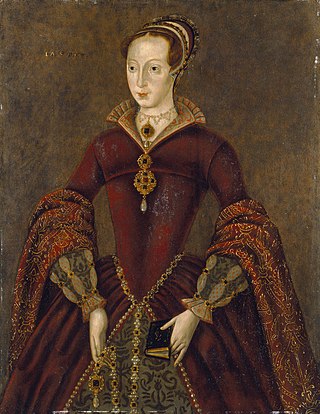
Lady Jane Grey, also known as Lady Jane Dudley after her marriage and as the "Nine Days' Queen", was an English noblewoman who claimed the throne of England and Ireland from 10 to 19 July 1553.
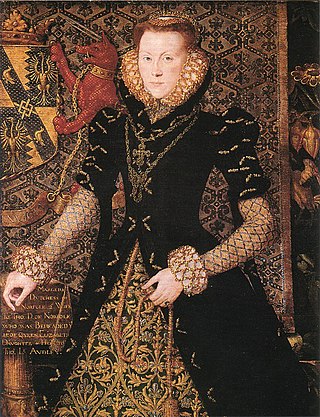
Margaret Howard, Duchess of Norfolk was the sole surviving child of Thomas Audley, 1st Baron Audley of Walden, and Lady Elizabeth Grey, herself the daughter of Thomas Grey, 2nd Marquess of Dorset, and his wife Margaret Wotton, therefore Margaret was a niece of Henry Grey, 2nd Duke of Suffolk and first cousin of Lady Jane Grey.
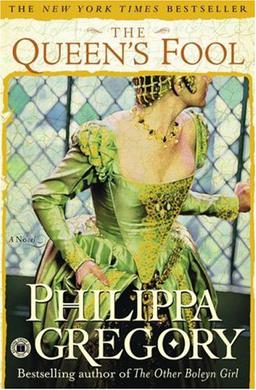
The Queen's Fool by Philippa Gregory is a 2003 historical fiction novel. Set between 1548 and 1558, it is part of Philippa Gregory's Tudor series. The series includes The Boleyn Inheritance. The novel chronicles the changing fortunes of Mary I of England and her half-sister Elizabeth through the eyes of the fictional Hannah Green, a Marrano girl escaping to England from Spain where her mother was burned at the stake for being Jewish. Hannah is discovered by Robert Dudley and John Dee and subsequently begged as a fool to Edward VI. She witnesses and becomes caught up the intrigues of the young king's court, and later those of his sisters. As Mary, Elizabeth, and Robert Dudley use Hannah to gather information on their rivals and further their own aims, the novel can plausibly present each side in the complex story. The Queen's Fool follows Hannah from ages fourteen to nineteen, and her coming-of-age is interspersed among the historical narrative. The book reached # 29 on the New York Times Best Seller list and had sold 165,000 copies within three weeks of its release.
Alison Weir is a British author and public historian. She primarily writes about the history of English royal women and families, in the form of biographies that explore their historical setting. She has also written numerous works of historical fiction.
Events from the 1550s in England. This decade marks the beginning of the Elizabethan era.

Lady Jane Grey, 16th-century claimant to the English throne, has left an abiding impression in English literature and romance. The limited amount of material from which to construct a source-based biography of her has not stopped authors of all ages filling the gaps with the fruits of their imagination.
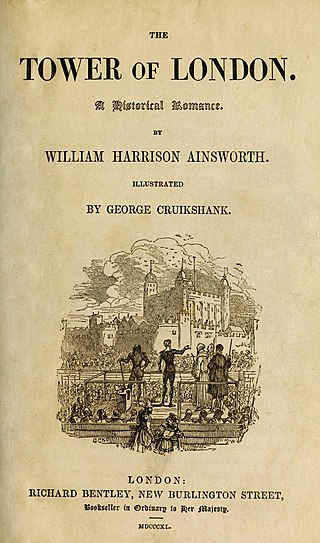
The Tower of London is a novel by William Harrison Ainsworth serially published in 1840. It is a historical romance that describes the history of Lady Jane Grey from her short-lived time as Queen of England to her execution.
Jane Dudley, Duchess of Northumberland was an English courtier. She was the wife of John Dudley, 1st Duke of Northumberland, and mother of Guildford Dudley and Robert Dudley, 1st Earl of Leicester. Having grown up with her future husband, who was her father's ward, she married at about age 16. They had 13 children.
Sir Thomas Wyatt is a history play published in 1607 and written in collaboration by John Webster and Thomas Dekker. It was probably first performed in 1602.

The Tragedy of Lady Jane Grey, often shortened to Lady Jane Grey, is a 1715 tragedy by the British writer Nicholas Rowe. It portrays the brief reign of Lady Jane Grey, a pretender to the English throne following the death of Edward VI and her defeat and execution by Mary I in 1554. The title role was played by the prominent actress Anne Oldfield. The cast also included John Mills as the Duke of Northumberland, Barton Booth as Lord Guilford Dudley and Lacy Ryan as the Earl of Sussex, Colley Cibber as Bishop Gardiner, James Quin as the Lieutenant of the Tower and Mary Porter as the Duchess of Suffolk.















